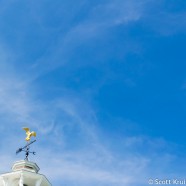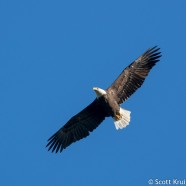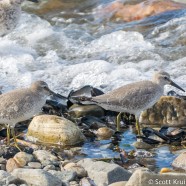Harley the Duck
We use the name “Harley” for this continuing drake Harlequin Duck at Stratford Point, and here is a daily progress shot of Harley’s plumage from several hours ago. He’s matching the blue waves more and more!
Read MoreDrake Harlequin Duck Swimming
Here is our pal the drake Harlequin Duck (Histrionicus histrionicus) making steady progress molting into his beautiful blue plumage. The species loves rocky, surf-battered coastal shores like ours here at Stratford Point in Stratford, Connecticut, and you can see it eagerly and adeptly riding the waves right at the tip of the point in between feeding. Growing in so many new feathers takes a lot of energy. It also means that a lot of maintenance has to be done, and he preens almost endlessly when he is not feeding or swimming. This growth reduces his flight skill and stamina, and migrating...
Read MoreNorthern Harrier Migrant
Can you spot the bird in this photo? Good luck! It is a migrant from the Boothe Park Hawk Watch, and it is in the upper right third of the picture. High in the sky in a suburban park is also not where you would normally imagine spotting one. It is a Northern Harrier (Circus cyaneus) on the way south for the winter, heading down the Housatonic River corridor to find Long Island Sound and the Atlantic coast. Binoculars help to identify it, but even here you can see the long wings, long tail and soaring, light flight it takes at low levels over fields. Maybe it will use Stratford Point or other...
Read MoreBald Eagle
This Bald Eagle (Haliaeetus leucocephalus) was one of 36 migrant Bald Eagles recorded at the Boothe Park Hawk Watch on September 20, 2015, breaking our previous daily record of 22 that had been set on September 14, 2014. The next two days in the record books were of 20 Bald Eagles apiece, making it an especially strong Sunday. We have been off to a difficult start considering the record-shattering heat in September, but Osprey have been abundant – in fact, we soared by our yearly record of them already! Bald Eagles have also been strong in numbers overall as both formerly endangered...
Read MoreRed Knots
Last evening we found these juvenile Red Knots on the beach at Stratford Point along with Black-bellied Plovers, Semipalmated Sandpipers, Semipalmated Plovers and our first of fall Dunlin. In 2014, the U.S. Fish & Wildlife Service announced that the rufa subspecies of Red Knot was officially added to the United States Endangered Species Act, designated as “threatened”. We are already identifying the most significant staging and feeding areas in Connecticut through our work in the Audubon Alliance for Coastal Waterbirds, and we know this is a very important location for them. It is so...
Read More








